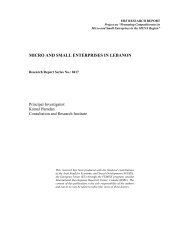local employment growth in the coastal area of tunisia - Economic ...
local employment growth in the coastal area of tunisia - Economic ...
local employment growth in the coastal area of tunisia - Economic ...
You also want an ePaper? Increase the reach of your titles
YUMPU automatically turns print PDFs into web optimized ePapers that Google loves.
5. Conclusion and policy implications<br />
This paper has tried to identify different sources <strong>of</strong> manufactur<strong>in</strong>g <strong>employment</strong> <strong>growth</strong> <strong>in</strong><br />
Tunisian <strong>coastal</strong> <strong>area</strong>. Exam<strong>in</strong><strong>in</strong>g <strong>the</strong> <strong>employment</strong> trends over a six-year period, we found<br />
that <strong>in</strong>dustrial <strong>employment</strong> decreased <strong>in</strong> metropolitan <strong>area</strong>s (Tunis, Sousse and Sfax)<br />
although surround<strong>in</strong>g <strong>area</strong>s (Bizerte, Zaghouan and Mounastir) become more attractive and<br />
subsequently <strong>the</strong>ir <strong>in</strong>dustrial <strong>employment</strong> levels <strong>in</strong>creased. Our analysis also provides<br />
evidence support<strong>in</strong>g <strong>the</strong> spatial spillover effects. Less range spillovers effects (15 km) has<br />
been detected for high-tech sectors (mechanical, electrical, electronic and chemical <strong>in</strong>dustry),<br />
as technological externalities for those sectors need face-to-face contacts and are limited to<br />
<strong>the</strong> closest neighbours. However, for <strong>the</strong> traditional sectors (textile, agro-food and<br />
construction), externalities can affect more distant <strong>area</strong>s (50 km). Our empirical results<br />
suggest also that market size and education have positive and significant impacts on<br />
manufactur<strong>in</strong>g <strong>employment</strong> <strong>growth</strong>. Low wage levels attract firms and <strong>in</strong>vestors. Firm’s<br />
competition has negative and significant <strong>in</strong>stant effects, but positive one-year lagged effects.<br />
In terms <strong>of</strong> policy recommendations, previous results will help us to identify <strong>the</strong> impact <strong>of</strong><br />
<strong>local</strong> economical structure, which is currently one <strong>of</strong> <strong>the</strong> crucial issues for policymakers<br />
attempt<strong>in</strong>g to draw up specific regional development programs. Thus, one <strong>of</strong> <strong>the</strong> recurr<strong>in</strong>g<br />
questions concern<strong>in</strong>g policy adopted by <strong>local</strong> authorities is to develop <strong>the</strong> territorial<br />
attractiveness and to <strong>in</strong>crease <strong>local</strong> <strong>employment</strong>. In order to assess <strong>the</strong>se regional programs,<br />
fur<strong>the</strong>r studies on <strong>the</strong> <strong>local</strong> <strong>employment</strong> <strong>growth</strong> are necessary to comprehend <strong>the</strong> selection<br />
process and regional development programs while respect<strong>in</strong>g <strong>the</strong> characteristics <strong>of</strong> each<br />
region. Given <strong>the</strong> economic and political situation after <strong>the</strong> January 14 th revolution, Tunisia<br />
needs to th<strong>in</strong>k seriously about solutions at <strong>local</strong> scale that can reduce un<strong>employment</strong> rate and<br />
<strong>the</strong> social exclusion <strong>in</strong> <strong>the</strong> non-<strong>coastal</strong> <strong>area</strong>. Policy discussion should be framed not at <strong>the</strong><br />
national level, but it should be framed at <strong>the</strong> <strong>local</strong> level such as delegations or villages. The<br />
concentration <strong>of</strong> economic activity <strong>in</strong> a few delegations <strong>of</strong> <strong>the</strong> <strong>coastal</strong> zone is itself desirable<br />
however <strong>the</strong> spatial disparities <strong>in</strong> welfare associated with this process are mostly unwelcome.<br />
Policy makers should reckon with <strong>the</strong> urbanisation degree <strong>of</strong> each community. For <strong>area</strong>s <strong>of</strong><br />
<strong>in</strong>cipient urbanisation (<strong>the</strong> case <strong>of</strong> most non-<strong>coastal</strong> <strong>area</strong>s <strong>of</strong> <strong>the</strong> country), <strong>the</strong> policy<br />
challenge should facilitate agglomeration forces and density. This step can give rise to a<br />
strong economic core <strong>in</strong> a suitable environment. For <strong>area</strong>s <strong>of</strong> <strong>in</strong>termediate urbanisation (like<br />
Zaghouan, Mehdia, Bizerte, and Mounastir from <strong>coastal</strong> <strong>area</strong>) government should build<br />
density and reduce economic distance. Distance measures how easily capital flows, labour<br />
moves, goods are transported and services are delivered between two locations (see chapter 2<br />
<strong>of</strong> 2009 World Bank report, for more details). The <strong>in</strong>frastructure to support this situation must<br />
be put <strong>in</strong> place to provide connectivity and reduce <strong>the</strong> time coast between different <strong>area</strong>s. For<br />
<strong>area</strong>s <strong>of</strong> advanced urbanisation (Great Tunis, Sfax and Sousse) government should build<br />
density, overcome distance and control <strong>the</strong> negative externalities <strong>of</strong> agglomeration.<br />
12

















